Asian Food in Japan: A Spicy Smorgasboard
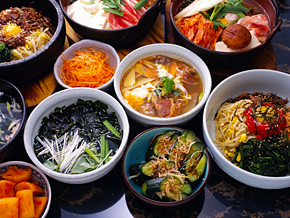
Cuisine varies greatly across the continent of Asia, both between countries and even within countries. From the clean and fresh, vegetable-rich dishes of Vietnam to the rich, complex curries of india, sweet and sour rice-dishes of Indonesia. Amongst other Asian cuisines, Japan differs in its minimal use of herbs and spices. The main flavorings in Japanese cuisine are sugar, salt, sake, mirin, vinegar, soy sauce and dashi stock. So when you want to try so food with more complex, robust flavors, there are many other Asian cuisines to try in Japan.
In addition to restaurants specializing in food from a specific country, there are also ethnically-mixed restaurants and specialty curry shops. Asian foods are also sometimes offered as limited time menu items at family restaurants.
Ingredients with Strong Aromas and Spices
A lot of Asian cuisines include dishes with large amounts of chili pepper or cilantro, so it’s best to check menus beforehand to see if the dish includes ingredients you don't like, and mention this to the waitstaff when you order.
Discover Other Asian Cuisines in Japan
Korean Food in Japan
Korean food is renowned for being hot, spicy and full of flavor. It uses many different kinds of spices in a wide variety of styles, from meat cuisine to health foods. Different to Japanese cuisine, Korean food is eaten with metal chopsticks and a spoon.
Many Korean restaurants cater to Japanese tastes, but some offer more authentic Korean food to satisfy the appetites of the many Koreans living in Japan. Korean cuisine is famous for its use of chili pepper, where it is used in many things like kimchi (pickled cabbage) and sundubu chige, a kind of tofu hot pot. However, it is believed that Korea only first started to use chili peppers around 200 years ago - before that, kimchi and other pickled items before then were not spicy. If you’re not a fan of spicy food, don’t worry as there are plenty of non-spicy Korean dishes as well.
Typical Korean Dishes

Samugetan (samgetang): Soup made from chicken, ginseng, and other ingredients.

Kimchi chige (kimchi jjigae): Spicy hot pot nabe made with kimchi.
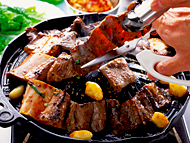
Karubi (galbi): Marinated and grilled beef short ribs.

Samugyopusaru (samgyeopsal): Grilled pork belly.

Chijimi (jijim): Flour mixed with green onions or other ingredients, grilled like a pancake, then served with a dipping sauce.
Takkarubi (dak galbi): Chicken and vegetables stir-fried in a spicy sauce.
Thai Food in Japan
Thai food is hot and spicy and uses many different kinds of spices, but also uses sweet and sour flavors mixed with a rich mix of spices and herbs such as cilantro - although chefs may often alter the amount of cilantro used for people who don't like it. Thai food is also known for seasoning with a fermented fish sauce called "nam pla."
Typical Thai Dishes

Tomu yamu kun (tom yum kung): Spicy and sour shrimp soup.
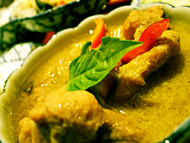
Gurin kare (green curry): Chicken and vegetables simmered in coconut milk mixed with a spice paste, then served over steamed rice.
Pattai (pad thai): Shrimp and vegetables stir-fried with rice noodles.
Vietnamese Food in Japan
Vietnamese food is influenced by both Chinese and French cuisine. Vietnamese food is well known for seasoning with a fermented fish sauce called "nuoc mam." Vietnamese food is mildly seasoned, and, like Thai cuisine, features a common use of cilantro.
Typical Vietnamese Dishes
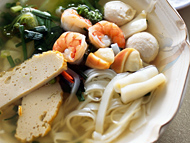
Fo (pho): Noodle soup using rice noodles.
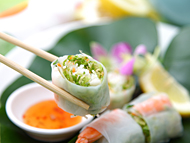
Nama harumaki (summer roll): Appetizer made from shrimp, seafood, raw vegetables and rice noodles wrapped in rice paper. These may also be called "goi-kun" (goi cuon).
Bain-seo (banh xeo): Ingredients such as pork, shrimp, and bean sprouts, are sauted with wrapped in a pancake and served with cilantro and a dipping sauce. This pancake is made from a dough of rice flour, turmeric, and coconut milk, which is rolled out and fried.
Indian Food in Japan
Indian food uses lots of different spices. Curry, where ingredients are stewed together with various spices, is well-known around the world. The traditional way to eat Indian food is not with a spoon or fork, but directly with one's right hand.
Indian food uses lots of spices. Curry, where ingredients are stewed together with various spices, is well-known around the world. The level of spiciness can usually be adjusted, so tell the chef if you would like a non-spicy version of your meal. For religious reasons, some restaurants have vegetarian dishes.
Typical Indian Dishes
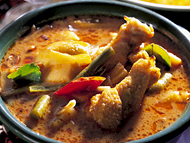
Chikin kare (chicken curry): Chicken and vegetables stewed with spices.
Horenso kare (spinach curry): Green curry made with spinach paste and spices. Sometimes cheese or chicken may be added.
Kima mataru (keema matar): Curry of ground meat and vegetables stewed with spices.
Nan (naan): Bread baked in a tandoor oven. This is usually eaten along with curry.
Taiwanese Food in Japan
Taiwanese food is influenced by both Fujian and Japanese cuisines. Seafood and vegetables are common ingredients.

Aona itame: Green vegetables such as water spinach stir-fried with garlic.
Tan-tsu-men: Noodles soup with miso-flavored ground meat and vegetables.
Cambodian Food in Japan
Compared to its neighbors, Cambodian food uses less chili pepper and cilantro, and has a relatively mild flavor. Cambodian foods are usually eaten together with rice.
Typical Cambodian Dishes
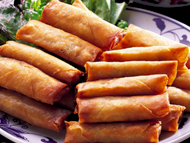
Chayo (chaio yor): Cambodian-style spring roll (various ingredients wrapped in rice paper and fried).
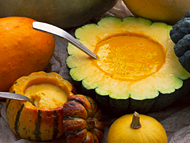
Kabocha pudding (pumpkin pudding): Dessert of pudding made with duck eggs poured into a hollowed-out pumpkin and steamed.
Kui-tiu (kuy teav): Noodle soup using rice noodles.
Indonesian Food in Japan
Indonesian food is the cuisine eaten in the area surrounding Indonesia. Indonesian food uses lots of spices and cilantro.
Typical Indonesian Dishes
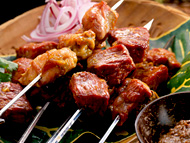
Sate (satay): Meat grilled on skewers.
Nashi goren (nasi goreng): Chicken and vegetables flavored with sambal sauce, made from chili peppers, cilantro, tomatoes and other ingredients, then stir-fried with rice. Topped with prawn crackers and a sunny-side up egg.
Nepalese Food in Japan
Nepalese food is influenced by Indian and Tibetan cuisines. It uses lots of beans and vegetables and has a relatively mild flavor.
Typical Nepalese Dishes
Tarukari (tarkari): Beans stewed with vegetables and spices.
Chapati: Whole-grain dough flattened and baked. Often eaten with tarkari.
Momo: Dumplings of ground lamb meat and diced vegetables wrapped in flour dough and steamed.
Sri Lankan Food in Japan
Sri Lanka is in a hot region surrounded by ocean, and therefore most Sri Lankan foods use seafood and are slightly spicy.
Typical Sri Lankan Dishes
Sakana kare (fish curry): Fish and vegetables are stewed in spices and coconut milk and eaten together with rice or roti. This is a spicy dish.
Roti: Bread made from baked flour dough.
Spice Things up with Different Asian Dishes in Japan
While there is so much food to try in Japan, with its traditional and modern cuisine, it is worth trying other Asian dishes. Especially if you enjoy spicy food! Korean, Indian, Vietnamese - and many other Asian cuisines - are abundantly available and of a very high standard. Browse Gurunavi’s listings to find a restaurant near you.


